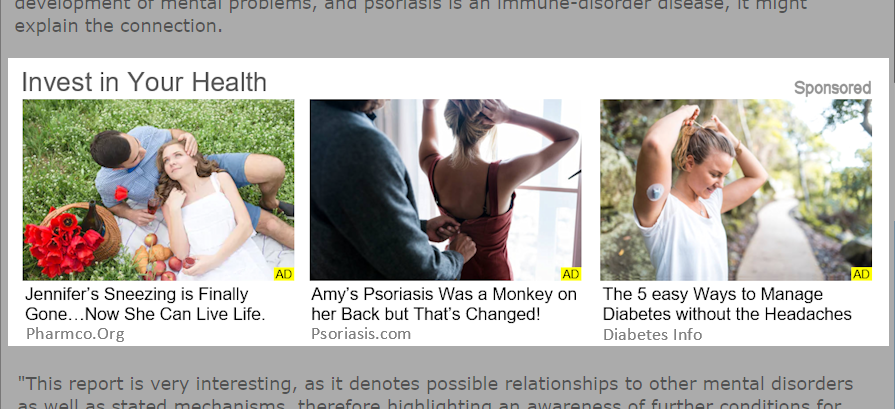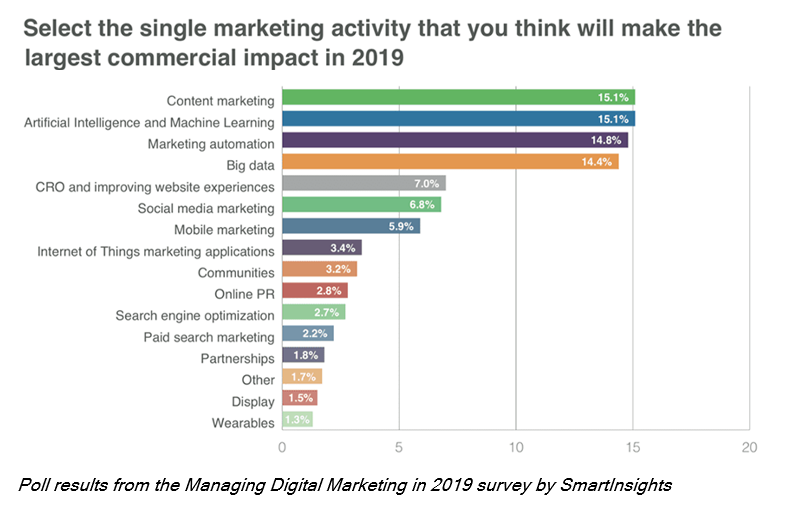Pharmaceutical Native Advertising
A look into how native advertising works, what cost benefits they provide, and measuring their success.
As engagement with traditional display advertising continues to decline, 70% of individuals want to learn about products via content vehicles rather than through traditional advertising. Nearly 15% of healthcare marketers believe content marketing will make one of the largest commercial impacts in marketing this year (see graphic below), and native ads are an important component.
Native advertising-paid ads that blend into the media formats in which they appear-will account for 62.7% of US display advertising in 2019, up from 54.2% in 2017. There’s no doubt that it has moved to the forefront of advertising interest, and that’s because native ads generate greater engagement and more clicks than traditional banner and display ads.
How native ads work
Display advertising may do an adequate job of delivering a product claim or creating brand awareness. Native ads, on the other hand, are not about branding; they are about driving specific audiences into your sales and marketing funnel.
Content-style native ads are placed within relevant editorial content. When clicked on, they drive traffic to strategically developed editorial. The characteristics of the ads can provide a deeper, more valuable, and cohesive experience for users. Native ads receive greater consideration than typical display ads. Their format and placement lend credibility, and act as a bridge to a relatable brand or patient story. As a result, audiences are far more likely to engage and to do so in a more meaningful way than through traditional ads.
Notice that the three native ad examples featured in the below graphic call out conditions rather than promote a brand. Ideally, native ads will kick off a journey to discover a brand through clearly labeled ads, pages, sites, and information. Patients in the avoidance stage of their condition can view a native ad in a related health article (for example, a psoriasis ad in a psoriasis article, see Figure 1), which helps them realize people just like themselves have overcome the burdens associated with the condition. They are then more accepting of tools and information that educate them about different treatment options and how to talk with a doctor.
Figure 1

Cost advantages
As a result of their integration with editorial, native ads can produce as much as 30 times the click rate of a display banner and often for much less money.
Companies may be used to paying display ad rates of around $10 CPM-that’s one click per 1,000 impressions, which is a $10 cost per click (CPC). Buyers of native advertising can expect the average CPC to be far less, in the $1 to $5 range, depending on targeting and provider. By using unbranded ads, marketers may be able to tap into a group of users that has been resistant to standard display ads.
Regulatory matters
Because pharma marketing is highly regulated, marketers tend to be conservative, especially when venturing into new territory. FDA has not provided clear guidance on native advertising. Consequently, the wisest course of action is to apply existing advertising guidelines to any native ads. Marketers should ensure that all communications-both the ad and subsequent editorial-are clear and do not contain any misleading information, and that ads are clearly marked as such.
If native ads are targeted based on the content of the article rather than using trackable user information such as cookies, this alleviates most privacy, HIPAA, FDA, and other regulatory guidelines, because users have not been tracked or targeted.
Creating native ads
Building native ads is faster and easier than creating display banners. Native ads typically consist of four elements: an image, a headline, a source or brand, and a landing page URL. These more generic assets are often less burdensome and expensive to obtain and get approved.
For best results, marketers should create many versions of a native ad, which can be A/B tested to discover which ones drive the most engagement. Analytic and conversion tracking tools can measure user actions downstream and produce data to guide decisions. Execution can easily be done through an advertising agency or handled in-house by using various self-serve interfaces.
Measuring success
Different metrics determine a native ad’s success. Most native ads are featured below the page fold and charge on a CPC basis, rather than a CPM. In addition, most native ads are not branded. When this is the case, ad viewability becomes far less important and downstream indictors are far more important. Such indicators include metrics that demonstrate how users are engaging with tools and content offered on the destination site. Some interactions are better indications that a user is close to seeking a prescription and are, therefore, worth paying for.
For example, is a downloaded savings card for your brand worth a $60 cost per acquisition (CPA) if 50% of downloads end up seeking a prescription? Some pharma brands can only dream of having a $120 CPA.
Figure 2

There are numerous web actions that can be measured, and many native ad providers offer conversion tracking pixels in order to attribute specific web actions with your campaigns.
Pharma brands of all types are already testing contextually placed native ads in order to experience the results firsthand. Marketers that take early advantage of this powerful advertising opportunity can see considerable results, such as reaching more users in the avoidance and assessment stages, and seeing boosts in brand affinity, response rates, and prescription seeking intent. Ultimately, native ad formats may offer marketers a less intrusive and more effective advertising medium that provides real value to readers.
As more pharma brands develop and adopt native advertising and content marketing strategies, brands that do not adapt may see less awareness, fewer visits to their sites, less social buzz, and ultimately, a decreasing market share.
Rafael Cosentino is VP, Business Development, Tap Native
Addressing Disparities in Psoriasis Trials: Takeda's Strategies for Inclusivity in Clinical Research
April 14th 2025LaShell Robinson, Head of Global Feasibility and Trial Equity at Takeda, speaks about the company's strategies to engage patients in underrepresented populations in its phase III psoriasis trials.
Beyond the Prescription: Pharma's Role in Digital Health Conversations
April 1st 2025Join us for an insightful conversation with Jennifer Harakal, Head of Regulatory Affairs at Canopy Life Sciences, as we unpack the evolving intersection of social media and healthcare decisions. Discover how pharmaceutical companies can navigate regulatory challenges while meaningfully engaging with consumers in digital spaces. Jennifer shares expert strategies for responsible marketing, working with influencers, and creating educational content that bridges the gap between patients and healthcare providers. A must-listen for pharma marketers looking to build trust and compliance in today's social media landscape.

.png&w=3840&q=75)

.png&w=3840&q=75)



.png&w=3840&q=75)



.png&w=3840&q=75)









